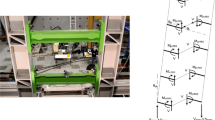Abstract
Rigorous design of flexible rockfall protection systems requires an adequate understanding of the system performance. In recent decades, finite element simulations have complemented experimental testing for economical and practical reasons. However, complex modelling techniques are required to capture the dynamic response of such systems, which leads to considerable computational costs. This paper presents a new approach called “hybrid method” to improve the computational efficiency of FE models with minimum effects on the results accuracy. The method is based on the idea to model the exact architecture of the wire net in the vicinity of impact (zone undergoing plastic deformation and failure) and to model the mesh with less computationally expensive elements far from the impact (zones undergoing elastic deformation). To this aim, a three-dimensional model of chain-link mesh was developed using commercial finite element code ABAQUS. The real architecture of the wires is modelled and discretised using three-dimensional beam elements. Homogenised shell surfaces are used to model the chain-link away from the impact zone. The model was calibrated and validated against published experimental data. The results prove that the proposed hybrid method leads to considerable reduction in computational costs of the finite element analysis while producing accurate results.



(modified after ABAQUS Analysis User’s Manual)
















Similar content being viewed by others
Abbreviations
- a :
-
The smaller diagonal of the chain-link rhomboid
- b :
-
The larger diagonal of the chain-link rhomboid
- θ :
-
The smaller angle of the chain-link rhomboid
- ω :
-
The aperture size of the chain-link rhomboid
- d :
-
The diameter of the chain-link wires
- \(\eta\) :
-
Stress triaxiality
- p :
-
Hydrostatic pressure
- q :
-
Mises equivalent stress
- \(\dot{\bar{\varepsilon }}^{\text{pl}}\) :
-
Equivalent plastic strain rate
- \(\dot{\varepsilon }^{\text{pl}}\) :
-
Plastic strain rate
- \(D\) :
-
Damage factor
- \(\alpha_{\text{damage}}\) :
-
Exponent of the damage evolution law formulation
- \(\bar{u}^{\text{pl}}\) :
-
Equivalent plastic displacement
- \(\bar{u}^{\text{pl}}_{\text{f}}\) :
-
Equivalent plastic displacement at failure
- L :
-
Characteristic length of the element
- V imp :
-
Block impact velocity
- V ini :
-
Block initial velocity
- g :
-
Gravity acceleration
- h :
-
Vertical distance between the block and the mesh at the end of gravity step
- h 1 :
-
Initial distance (before gravity step) between the block and the mesh
- h 2 :
-
Initial sag of the mesh at the end of gravity step
- ε :
-
Strain
- E :
-
Young’s modulus
- ν :
-
Poisson ratio
- G :
-
Shear modulus
- σ :
-
Stress
- ρ :
-
Density
- \(A_{\text{sh}}\) :
-
Area of the shell surface
- M :
-
Mass of the mesh replaced with shell surface
- \(t_{\text{sh}}\) :
-
Thickness of the shell surface
References
ABAQUS (2011) ABAQUS/CAE 6.11 User’s Manual, Online Documentation Help. In: Dassault Systèmes
Anderheggen E, Volkwein A, Grassl H (2002) Numerical simulation of highly flexible rockfall protection systems. In: Fifth world congress on computational geomechanics, Vienna, Austria
Bertrand D, Nicot F, Gotteland P, Lambert S (2008) Discrete element method (DEM) numerical modeling of double-twisted hexagonal mesh. Can Geotech J 45(8):1104–1117
Breugnot A, Lambert S, Villard P, Gotteland P (2016) A discrete/continuous coupled approach for modeling impacts on cellular geostructures. Rock Mech Min Sci 49(5):1831–1848
Buzzi O, Giacomini A, Spadari M, Fityus S (2011) Numerical modeling of a rock fall mesh perforation upon impact In: 13th international conference of IACMAG, Melbourn, Australia
Buzzi O, Leonarduzzi E, Krummenacher B, Volkwein A, Giacomini A (2015) Performance of high strength rock fall meshes: effect of block size and mesh geometry. Rock Mech Rock Eng 48:1221–1231
Cazzani A, Mongiovì L, Frenez T (2002) Dynamic finite element analysis of interceptive devices for falling rocks. Int J Rock Mech Min Sci 29:303–321
Duffy JD, Hoon W (1996a) Field Tests and Evaluation of Hi-Tech Low Energy Chain Link Rockfall Fence, Report No. CA/05-96-01. In: California Department of Transportation, San Luis Obispo, California, USA
Duffy JD, Smith DD (1990) Field test and evaluation of rockfall restraining nets. Research Report CA/TL-90/05. In: California Department of Transportation
EOTA (2008) ETAG 027: guideline for European technical approval of falling rock protection kits; 06, 2013
Escallón JP, Boetticher V, Wendeler C, Chatzi E, Bartelt P (2015) Mechanics of chain-link wire nets with loose connections. Eng Struct 101:68–87
Gentilini C, Govoni L, de Miranda S, Gottardi G, Ubertini F (2012) Three-dimensional numerical modelling of falling rock protection barriers. Comput Geotech 44:58–72
Grassl H, Bartelt P, Volkwein A, Wartmann S (2003) (2003). Experimental and numerical modelling of highly flexible rockfall protection barriers. In: 12th Panamerican conference on soil mechanics and geotechnical engineering, Cambridge, Massachusetts, USA, pp 2589–2594
Hearn G (1992) High-capacity flexpost rockfall fences. In: Colorado Department of Transportation, Denver, Colorado
Mentani A, Govoni L, Gottardi G, Lambert S, Bourrier F, Toe D (2016) A new approach to evaluate the effectiveness of rockfall barriers. Procedia Eng 158:398–403
Mentani A, Govoni L, Giacomini A, Gottardi G, Buzzi O (2018) An equivalent continuum approach to efficiently model the response of steel wire meshes to rockfall impacts. Rock Mech Rock Eng 2018:1–14
Muhunthan B, Shu S, Sasiharan N, Hattamleh OA (2005) Analysis and design of wire mesh/cable net slope protection. In: Washington State Department of Transportation, Washington
Nilakantan G, Keefe M, Bogetti TA, Adkinson R, Gillespie JW (2010) On the finite element analysis of woven fabric impact using multiscale modeling techniques. Int J Solids Struct 47(17):2300–2315
Peila D, Pelizza S, Sassudelli F (1998) Evaluation of behaviour of rockfall restraining nets by full scale tests. Rock Mech Rock Eng 1998:1–24
Persson BNJ (2000) Sliding friction: physical principles and applications, nanoscience and technology. Springer, Berlin
Thoeni K, Lambert C, Giacomini A, Sloan S (2011) Discrete modelling of a rockfall protective system. In: International conference on particle-based methods—fundamentals and applications, pp 24–32
Toe D, Mentani A, Govoni L, Bourrier F, Gottardi G, Lambert S (2018) Introducing meta-models for a more efficient hazard mitigation strategy with rockfall protection barriers. Rock Mech Rock Eng
Tran PV, Maegawa K, Fukada S (2012) Experiments and dynamic finite element analysis of a wire-rope rockfall protective fence. Rock Mech Rock Eng 46:1183–1198
Volkwein A (2005) Numerical simulation of flexible rockfall protection systems. In: Computing in civil engineering, Cancun, Mexico. http://www.Geobrugg.com
Author information
Authors and Affiliations
Corresponding author
Additional information
Publisher's Note
Springer Nature remains neutral with regard to jurisdictional claims in published maps and institutional affiliations.
Rights and permissions
About this article
Cite this article
Tahmasbi, S., Giacomini, A., Wendeler, C. et al. On the Computational Efficiency of the Hybrid Approach in Numerical Simulation of Rockall Flexible Chain-Link Mesh. Rock Mech Rock Eng 52, 3849–3866 (2019). https://doi.org/10.1007/s00603-019-01795-8
Received:
Accepted:
Published:
Issue Date:
DOI: https://doi.org/10.1007/s00603-019-01795-8




